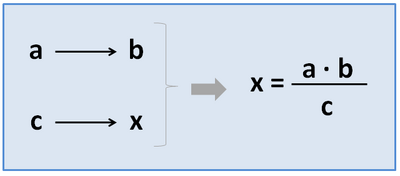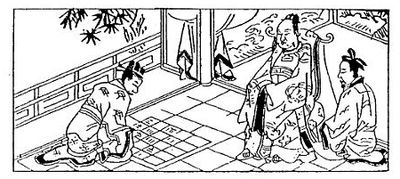By: Tao Steven Zheng (郑涛)
Exchange Rates and Unit Conversions

Figure 1. The jin you method or "rule of three"
The concept of "rate" or "proportion" (率 lü) was highly important in ancient Chinese mathematics. We will later discover that rates are vital in explaining the Chinese understanding of applied problems in arithmetic, linear equations, and even geometry. One important method discussed in Chapter 2, titled "Grains" (粟米 su mi), of the Jiuzhang Suanshu is the jinyou method (今有术 jin you shu). The jinyou method most likely arose from commercial transactions of antiquity, for every problem in this chapter dealt with the exchange of different grains that followed a defined market rate. The market rates are used to calculate an unknown quantity of grain. In the Jiuzhang Suanshu, at the beginning of Chapter 2 (粟米 su mi), a table of market rates of various grains is given, as well as a detailed description of the jinyou method.
| 粟米之法:
粺米二十七;糳米二十四 御米二十一;小䵂十三半 大䵂五十四;粝饭七十五 粺饭五十四;糳饭四十八 御饭四十二;菽、荅、麻、麦各四十五 稻六十;豉六十三 飧九十;熟菽一百三半 蘖一百七十五
|
The regulated [rates of exchange] for grains:
Milled millet 27; Refined millet 24 Imperial millet 21; Refined wheat 13 ½ Coarse wheat 54; Cooked coarse wheat 75 Cooked milled millet 54; Cooked refined millet 48 Cooked imperial millet 42; Soy beans, Small beans, Sesame seed, Wheat 45 Paddy rice 60; Fermented soy beans 63 Porridge 90; Cooked beans 103 ½ Fermented grain 175
|
What the jinyou method describes is the that given two rates, the given rate and sought rate , and the given amount , one can determine the sought amount as follows:
The jinyou method went by many names over the centuries and across different cultures. In ancient India, the astronomer-mathematician Aryabhata (476 - 550 AD) formulated a method for calculating rates equivalent to the jinyou method. Aryabhata called it the Trairāśika, which literally translates to the "rule of three quantities". Knowledge of the jinyou method travelled along the Eurasian trade routes (often called the Silk Road), making its way to the Middle East and Europe through India. For centuries, the mathematicians and merchants of Muslim empires and Christian Europe still refer it as the "rule of three".
Knowing how the jinyou method (rule of three) can be used for calculating rates, one will discover that the method can be extended to converting units of standard measures. In the Chinese language, there are three basic measures: linear measure (度 du), capacity measure (量 liang), and weight measure (衡 heng). Collectively they are referred to as 度量衡 (du liang heng, "weights and measures").
Table 1. Linear Measure (度 du)
| 10 毫 = 1 厘
10 厘 = 1 分 10 分 = 1 寸 10 寸 = 1 尺 10尺 = 1 丈 6 尺 = 1 步 40 尺 = 1 匹(疋) 50 尺 = 1 端 300 步 = 1 里 |
10 hao = 1 li
10 li = 1 fen 10 fen = 1 cun 10 cun = 1 chi 10 chi = 1 zhang 6 chi = 1 bu 40 chi = 1 pi 50 chi = 1 duan 300 bu = 1 li |
Table 2. Capacity Measure (量 liang)
| 10 圭 = 1 撮
10 撮 = 1 抄 10 抄 = 1 勺 10 勺 = 1 合 10 合 = 1 升 10 升 = 1 斗 10 斗 = 1 斛 |
10 gui = 1 cuo
10 cuo = 1 chao 10 chao = 1 shao 10 shao = 1 ge 10 ge = 1 sheng 10 sheng = 1 dou 10 dou = 1 hu |
Table 3. Weight Measure (衡 heng)
| 10 絫 = 1 铢
24 铢 = 1 两 16 两 = 1 斤 30 斤 = 1 钧 4 钧 = 1 石 |
10 lei = 1 zhu
24 zhu = 1 liang 16 liang = 1 jin 30 jin = 1 jun 4 jun = 1 dan* |
* The character 石 is pronounced shi for stone but the unit of measurement is pronounced dan.
Problem Study 1: Exchanging Grains
The following problem from the Jiuzhang Suanshu (Chapter 2, Problem 1) is an exercise of unit conversions and the jinyou method.
| [2.01] 今有粟一斗,欲为粝米。问:得几何?
|
[2.01] Suppose the is 1 dou of millet, and one wishes to exchange it for hulled millet. Question: How much should there be?
|
Let denote the sought amount of hulled millet. From the table of capacity measures (Table 2), we find that 10 sheng (升) makes 1 dou (斗). Thus, the given amount is 10 sheng of millet. Referencing the market rates from Chapter 2 of the Jiuzhang Suanshu, we find that the exchange rate for millet is 50, and the rate for hulled millet is 30. Substituting the given rates and the given amount of millet into the jinyou rule, we get
Problem Study 3: Application with Unit Conversions
The following problem is from Sunzi Suanjing (Chapter 3, Problem 33).
| 今有长安、洛阳相去九百里。车轮一匝一丈八尺。欲自洛阳至长安,问:轮匝几何?
术曰:置九百里,以三百步乘之,得二十七万步。又以六尺乘之,得一百六十二万尺。以车轮一丈八尺为法。除之,即得。
|
Suppose the distance between Chang’an and Luoyang is 900 li. One rotation of the cart’s wheel measures 1 zhang 8 chi. Question: If one wishes to travel from Luoyang to Chang’an, how many rotations will the wheel make?
|








